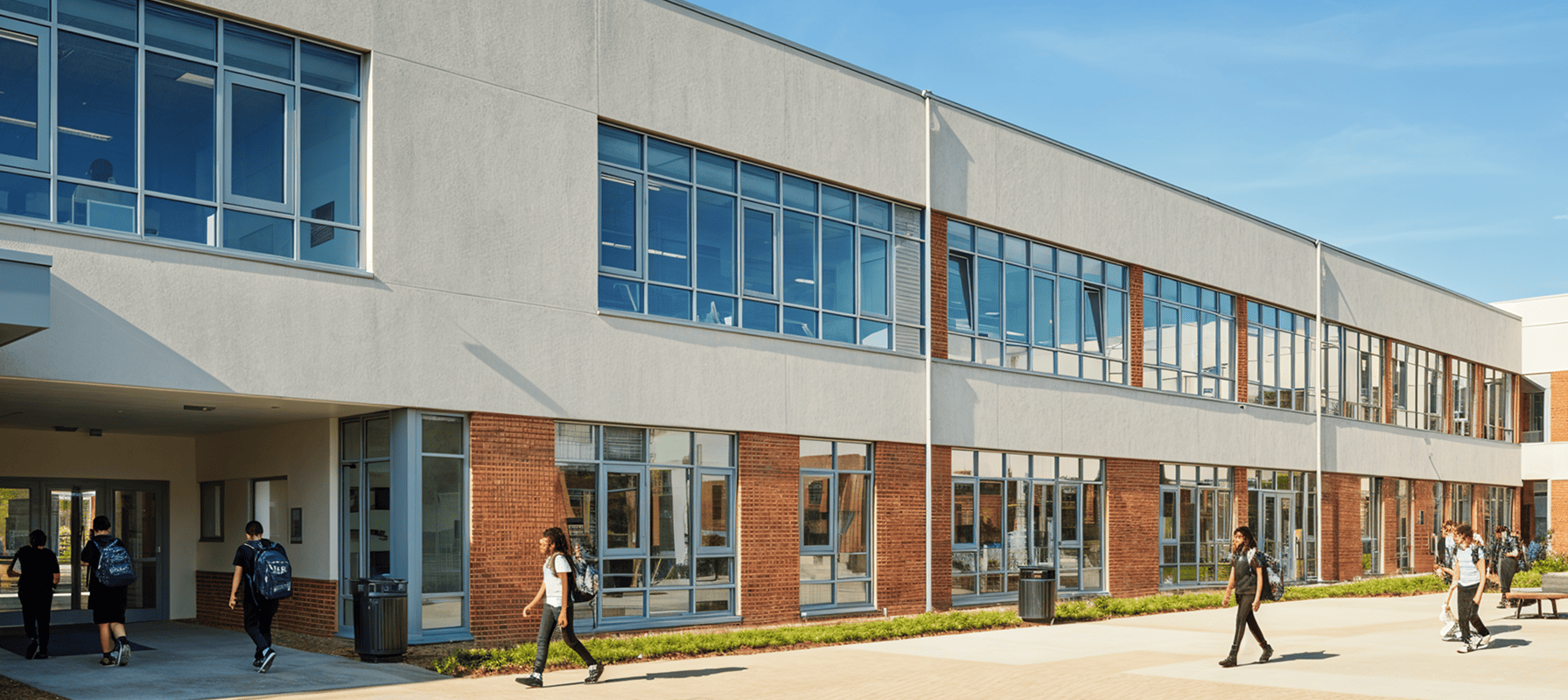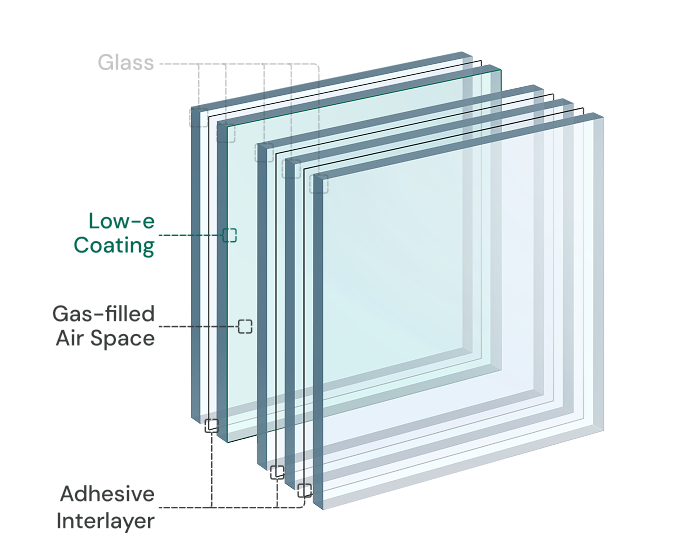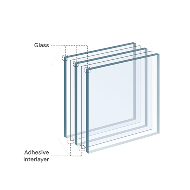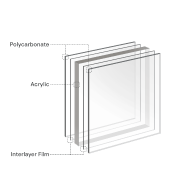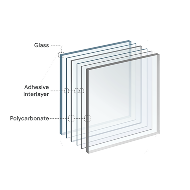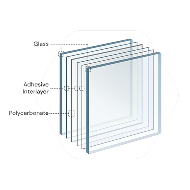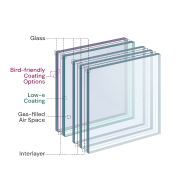




Bullet-Resistant Insulating Glass (IGU)
This glass make-up offers high-level protection while also providing energy efficiency and clarity. This configuration consists entirely of glass—no polycarbonates—delivering durability, low maintenance, and excellent optical quality. By combining multiple layers of glass with specialized interlayers, the bullet-resistant unit is designed to absorb and resist ballistic impact while maintaining structural integrity.
The insulating glass design also improves thermal performance, reduces sound transmission, and supports daylighting goals, making it an ideal choice for security-sensitive applications such as schools, government buildings, and commercial storefronts.
Make-Up Features
Ballistic Protection
The below chart refers to how much ballistic protection the Thompson Innovative Glass product provides, based on standardized testing. In the U.S., bullet-resistant glass is rated by UL 752 the standard for bullet-resistant materials set by Underwriters Laboratories (UL).
It defines testing methods and performance criteria for bullet-resistant glass, doors, panels, and other protective materials. and classified into a range of levels.
Get Expert Guidance on Defender Glass
Check with the Thompson Innovative Glass team for more details and options from our Defender line to find the right one for you and your application.

Applications- Security and Protection
Bullet-resistant and forced entry glass are critical components in protecting people and property across a wide range of high-risk environments. These specialized glazing solutions are trusted wherever enhanced security and peace of mind are essential, from public institutions to private facilities. Common applications include:

Schools
Security glazing enhances school safety by resisting forced entry and delaying intruders, providing critical response time without compromising light, visibility, or design.

Corporate Offices
Modern offices benefit from glass that provides energy efficiency and acoustic comfort—along with optional forced-entry and ballistic resistance for high-security needs.

Data Centers
Mission-critical data centers require fortified glass to secure sensitive infrastructure from both physical threats and unauthorized access.

Museums
Museums depend on specialty glass to protect exhibits and patrons from damage, while maintaining clarity, light control, and architectural beauty.

Retail Storefronts
These retail spaces utilize protective glass to deter crime and protect staff, particularly during overnight hours or high-traffic periods.

Financial Institutions
Banks and financial offices rely on secure glazing for transaction windows, teller areas, and entry points to protect employees and assets.
Maximum Size

Maximum size for Insulating Glass
72″ x 140″
Your Guide to Bullet-Resistant Glass Options
Discover all bird-friendly glass options in our brochure.
Download Now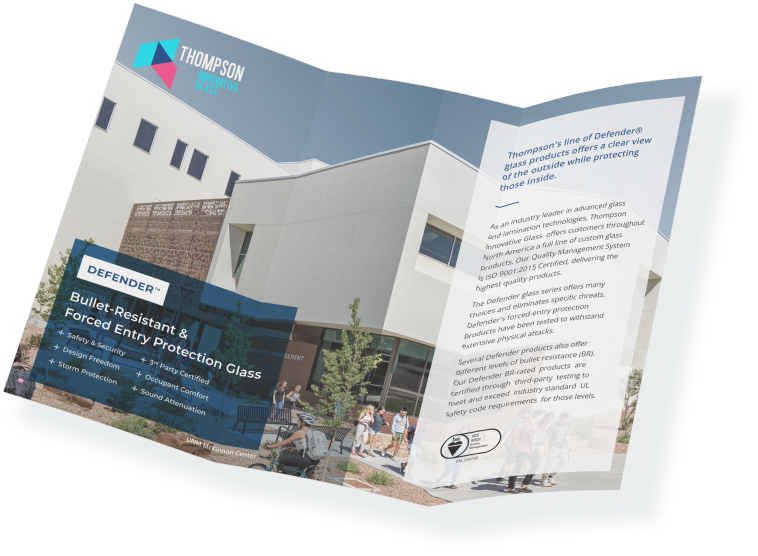
Frequently Asked Questions About Bullet-Resistant Glass
What is bullet-resistant glass?
Bullet-resistant glass, also known as ballistic glass, is a type of reinforced glass designed to resist penetration from bullets. It typically consists of multiple layers of glass and polycarbonate materials, laminated together to absorb and disperse the impact of projectiles.
How does bullet-resistant glass work?
When a bullet strikes the glass, the outer layer absorbs the impact, while the inner layers dissipate the energy and prevent penetration. The polycarbonate layers add flexibility and strength, ensuring the glass remains intact even after repeated hits.
Is bullet-resistant glass completely bulletproof?
No material is entirely bulletproof. Bullet-resistant glass is designed to slow or stop specific calibers of bullets based on its rating. Over time or with repeated impacts, even high-rated glass may fail.
What are the levels of bullet-resistance?
Bullet-resistant glass is rated according to standards such as the UL 752 in the U.S. or EN 1063 in Europe. These levels indicate the glass's ability to withstand specific types of firearms and ammunition.
Where is bullet-resistant glass typically used?
- Banks and financial institutions
- Government buildings
- Schools and universities
- Retail stores (especially jewelry or high-value merchandise)
- Private vehicles and armored transport
- Security booths and checkpoints
Can bullet-resistant glass be installed in existing structures?
Yes, retrofitting is possible. Bullet-resistant glass can be customized and installed in existing frames, though structural modifications may be required for proper support.
Does bullet-resistant glass look different from standard glass?
Modern bullet-resistant glass is designed to look clear and similar to standard glass. Some thicker or higher-rated options may have a slight tint due to the layers of materials.
How thick is bullet-resistant glass?
Thickness depends on the level of protection, ranging from 0.25 inches (Level 1) to over 2 inches (Level 8). Higher levels of protection generally require thicker glass.
Can bullet-resistant glass be combined with other features?
Yes, bullet-resistant glass can include additional properties like:
- Energy efficiency with low-E coatings.
- Fire resistance for enhanced safety.
- Privacy options like tinting or one-way visibility.
And now via Thompson Innovative Glass- we offer Bird Friendly properties with Bullet Resistant Glass.
How much does bulletproof glass cost?
Bullet-resistant glass typically costs 100% to 400% more than standard commercial glazing.
Pricing varies based on:
- Threat level (UL 752 Level 1–8)
- Glass type (all-glass, laminated, or glass-clad polycarbonate)
- Size, thickness, and installation needs
While more expensive, it provides vital protection in schools, government buildings, banks, and other high-risk environments.
What is bulletproof glass made from?
Bullet-resistant glass is made from multiple layers of glass and plastic (polycarbonate or PVB interlayers). These layers absorb and slow down bullets, dispersing the energy and preventing penetration.
How is bulletproof glass made?
At our state-of-the-art facility in Jenison, MI, bullet-resistant glass is fabricated by:
- Tempering or heat-strengthening the outer glass for durability.
- Layering sheets of glass and plastic.
- Laminating them under heat and pressure in an autoclave.
- Precision bonding for optical clarity and resistance.
The result is a strong, transparent barrier that can stop bullets while still functioning as a window.
How thick is bulletproof glass?
The thickness varies by protection level:
- Level 1 (handguns): ~1-1/8" thick
- Level 3 (high-powered handguns): ~1-1/4" thick
- Level 8 (rifles): can exceed 2"+
We offer several options depending on the security need, including all-glass and hybrid glass-polycarbonate constructions.
